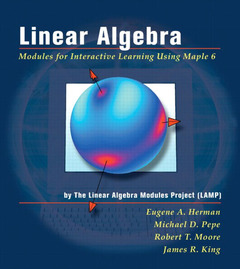Description
Linear algebra
Authors: (LAMP) Linear Algebra Modules, HERMAN Eugene, PEPE Michael, MOORE Rob
Language: English
Approximative price 36.09 €
Subject to availability at the publisher.
Add to cart
Publication date: 11-2000
496 p. · Paperback
496 p. · Paperback
Description
/li>Contents
/li>Comment
/li>
(Herman, Pepe, Moore, and King) Organized into a collection of 29 extensive (and intensive) modules, which must be used in conjunction with Maple 6. Each module is divided into an interactive Tutorial followed by a rich and substantial collection of problems, designed to help students develop their geometric intuition and deepen their understanding of linear algebra concepts and methods. These modules support both individual work and interactive collaboration.
Can be used as a supplement in a traditional lecture course, or in a lab-only format.
Can be used as a supplement in a traditional lecture course, or in a lab-only format.
1. Systems of Linear Equations.
2. Vectors.
3. Matrix Algebra.
4. Linear Transformations.
5. Vector Spaces.
6. Eigenvalues and Eigenvectors.
7. Orthogonality.
Geometric Perspectives on Linear Equations.
Solving Linear Systems Using Maple.
Some Applications Leading to Linear Systems.
Solving Linear Systems Using Maple.
Some Applications Leading to Linear Systems.
2. Vectors.
Geometric Representation of Vectors in the Plane: Linear Combinations of Vectors.
Decomposing the Solution of a Linear System.
Linear Independence of Vectors.
Decomposing the Solution of a Linear System.
Linear Independence of Vectors.
3. Matrix Algebra.
Product of a Matrix and a Vector.
Matrix Multiplication.
Rules of Matrix Algebra.
Markov Chains - An Application.
Inverse of a Matrix - An Introduction.
Inverse of a Matrix and Elementary Matrices.
Matrix Multiplication.
Rules of Matrix Algebra.
Markov Chains - An Application.
Inverse of a Matrix - An Introduction.
Inverse of a Matrix and Elementary Matrices.
4. Linear Transformations.
Geometry of Matrix Transformations of the Plane.
Geometry of Matrix Transformations of 3-Space.
Computer Graphics.
Geometry of Matrix Transformations of 3-Space.
Computer Graphics.
5. Vector Spaces.
Subspaces.
Basis and Dimension.
Subspaces Associated with a Matrix.
Loops and Spanning Trees - An Application to Networks.
Basis and Dimension.
Subspaces Associated with a Matrix.
Loops and Spanning Trees - An Application to Networks.
6. Eigenvalues and Eigenvectors.
Determinants.
Introduction to Eigenvalues and Eigenvectors.
Eigenspaces and Eigenvector Bases.
Eigenvector Analysis of Discrete Dynamical Systems.
Diagonalization and Similarity.
Introduction to Eigenvalues and Eigenvectors.
Eigenspaces and Eigenvector Bases.
Eigenvector Analysis of Discrete Dynamical Systems.
Diagonalization and Similarity.
7. Orthogonality.
Orthogonal Vectors and Orthogonal Projections.
Orthogonal Bases.
Least Squares Solutions.
Orthogonal Bases.
Least Squares Solutions.
- Goals of the Project:
- The main goals of the project are:
1. To help students develop their geometric intuition about the concepts of linear algebra,
2. To deepen students understanding of the algebraic formulation of these concepts and to strengthen their ability to manipulate concepts,
3. To help students gain an appreciation of how the concepts and methods of linear algebra are applied.
Structure of the Modules
- Each module is divided into two main parts, the Tutorial and the Problems:
The Tutorial is further divided into sections and consists of an interlaced text (usually brief), examples and demonstrations, and exercises (with answers provided in closed sections).
The Problems are all intended to be fairly
© 2024 LAVOISIER S.A.S.




